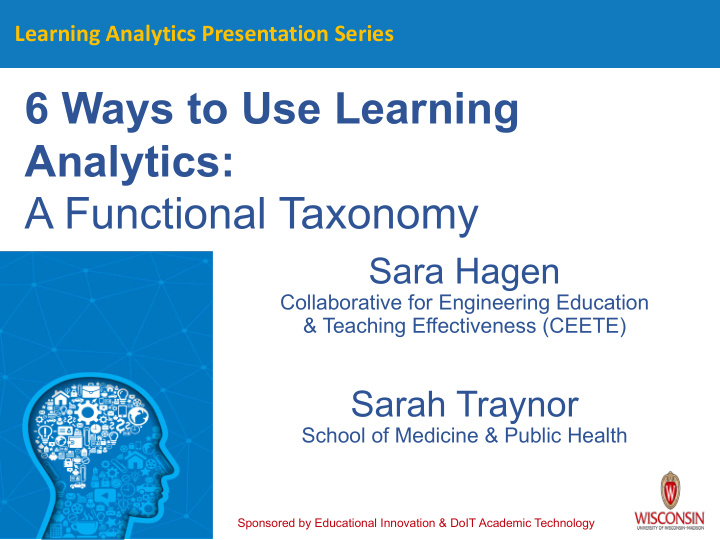



Learning Analytics Presentation Series 6 Ways to Use Learning Analytics: A Functional Taxonomy Sara Hagen Collaborative for Engineering Education & Teaching Effectiveness (CEETE) Sarah Traynor School of Medicine & Public Health Sponsored by Educational Innovation & DoIT Academic Technology
Learning Analytics Presentation Series This is the 1 st event in our learning SEPT 6 Ways to Use Learning Analytics: analytics 18 A Functional Taxonomy presentation series Sara Hagen & Sarah Traynor this fall. OCT The Importance of Meaning: 16 Going Beyond Mixed Methods to Turn Big Data into Real Understanding David Williamson Shaffer NOV TBD 13 Sponsored by Educational Innovation & DoIT Academic Technology
Blend@UW Fellowship, Spring 2018 Evidence- based teaching Learning Blended Analytics Learning
Learning Analytics Learning analytics is the measurement, collection, analysis and reporting of data about learners and their contexts , for PURPOSES of understanding and optimizing learning and the environments in which it occurs. --Society for Learning Analytics Research (SoLAR) Agenda: • Case Study • Functional Taxonomy = Purposes • Discussion
Case Study • Post-fellowship case study at SMPH • Approached two block leaders from new medical curriculum • What do they want to know about their students? Prework •Are the students completing prework prior to in- class sessions? •Enduring Learning Objects (ELOs) •Does student prework behavior vary throughout a semester? •Does student prework behavior vary between Phase 1 and Phase 2?
SMPH Learning Repository How students interact with material online should inform block leaders of student behavior, which is an indicator of how they gain knowledge, skills and approach learning.
Learning Locker • Capturing student behavior- every single click!* • Student A [ attempted, completed ] this ELO • Date/time accessed * Disclaimer for students on syllabus: "All student activity in the Canvas Learning Management System (LMS) and SMPH Learning Repository is tracked and logged and can be used by the instructor, department, school, or institution for learning analytics to improve the student learning environment."
Functional Taxonomy • Developed by Nguyen, Gardner, & Sheridan (2017) using machine learning* techniques and based on learning analytics literature Multiple Layers About what? When? Which data? Stakeholders? Expertise required? *Machine learning: the science of getting computers to act without being explicitly programmed
Functional Taxonomy https://blendedtoolkit.wisc.edu/fellowship/evidence-based-teaching/ Visualize Access Learning Learning Behaviors Activities Predict Student Individualize Performance Learning Improve Evaluate Social Learning Learning Materials & Tools
Predict Student Performance • Predict students' success and identify at-risk students • Early intervention • Important to establish expectations of Canvas use early. • Canvas use does not necessarily predict student performance
Access Learning Behavior • Offers trends of learning engagement • Click behavior • Student behavior in LMS • Students can modify their learning behavior
Individualize Learning • Adjustable content • Based on an assessment or ongoing progress • Seeks to fill gaps or provide acceleration • May be based on learning style preference • Focus on real-time continuous feedback
Visualize Learning Activities • Tracing all learning activities performed by Canvas course analytics – page views & participation users in a digital ecosystem • Produces visual reports on the learning process • Can support both students and teachers to boost learning motivation, adjust practices
Evaluate Social Learning • Understanding patterns of interaction • Student-student and student-instructor • What does a learning community look like? • Analyzing and categorizing interactions • Which interactions are indicative of learning?
Improve Learning Materials & Tools • Learning analytics offer an objective evaluation of learning materials and tools • Case study • We receive very little feedback from students about our online material • Knowing how the students are interacting with these materials online can lead to changes to the materials with each iteration • Improve organization of Canvas course pages
Questions are Key How do you choose your questions? Depends on your . . . •discipline •role •available data •goals •focus (course-level, program-level)
Thank you! https://blendedtoolkit.wisc.edu/fellowship/evidence-based-teaching/ Learning Analytics Presentation Series Sponsored by Educational Innovation & DoIT Academic Techology
Recommend
More recommend